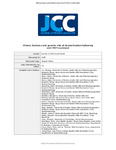Clinical features and genetic risk of demyelination following anti-TNF treatment
| dc.contributor.author | Lin, S | |
| dc.contributor.author | Green, H | |
| dc.contributor.author | Hendy, P | |
| dc.contributor.author | Heerasing, N | |
| dc.contributor.author | Chanchlani, N | |
| dc.contributor.author | Hamilton, B | |
| dc.contributor.author | Walker, G | |
| dc.contributor.author | Heap, G | |
| dc.contributor.author | Hobart, J | |
| dc.contributor.author | Martin, R | |
| dc.contributor.author | Coles, A | |
| dc.contributor.author | Irving, P | |
| dc.contributor.author | Chung-Faye, G | |
| dc.contributor.author | Cummings, F | |
| dc.contributor.author | Lytvyak, E | |
| dc.contributor.author | Andersen, V | |
| dc.contributor.author | Wood, A | |
| dc.contributor.author | Tyrrell, J | |
| dc.contributor.author | Beaumont, R | |
| dc.contributor.author | Weedon, M | |
| dc.contributor.author | Kennedy, N | |
| dc.contributor.author | Spiers, A | |
| dc.contributor.author | Harrower, T | |
| dc.contributor.author | Goodhand, J | |
| dc.contributor.author | Ahmad, T | |
| dc.date.accessioned | 2020-04-30T09:58:39Z | |
| dc.date.issued | 2020-05-04 | |
| dc.identifier.issn | 1873-9946 | |
| dc.identifier.issn | 1876-4479 | |
| dc.identifier.uri | http://hdl.handle.net/10026.1/15613 | |
| dc.description.abstract |
<jats:title>Abstract</jats:title> <jats:sec> <jats:title>Background</jats:title> <jats:p>Anti-TNF exposure has been linked to demyelination events. We sought to describe the clinical features of demyelination events following anti-TNF treatment and to test whether affected patients were genetically predisposed to multiple sclerosis [MS].</jats:p> </jats:sec> <jats:sec> <jats:title>Methods</jats:title> <jats:p>We conducted a case-control study to describe the clinical features of demyelination events following anti-TNF exposure. We compared genetic risk scores [GRS], calculated using carriage of 43 susceptibility loci for MS, in 48 cases with 1219 patients exposed to anti-TNF who did not develop demyelination.</jats:p> </jats:sec> <jats:sec> <jats:title>Results</jats:title> <jats:p>Overall, 39 [74%] cases were female. The median age [range] of patients at time of demyelination was 41.5 years [20.7–63.2]. The median duration of anti-TNF treatment was 21.3 months [0.5-99.4] and 19 [36%] patients were receiving concomitant immunomodulators. Most patients had central demyelination affecting the brain, spinal cord, or both. Complete recovery was reported in 12 [23%] patients after a median time of 6.8 months [0.1–28.7]. After 33.0 months of follow-up, partial recovery was observed in 29 [55%] patients, relapsing and remitting episodes in nine [17%], progressive symptoms in three [6%]: two [4%] patients were diagnosed with MS. There was no significant difference between MS GRS scores in cases (mean -3.5 × 10–4, standard deviation [SD] 0.0039) and controls [mean -1.1 × 10–3, SD 0.0042] [p = 0.23].</jats:p> </jats:sec> <jats:sec> <jats:title>Conclusions</jats:title> <jats:p>Patients who experienced demyelination events following anti-TNF exposure were more likely female, less frequently treated with an immunomodulator, and had a similar genetic risk to anti-TNF exposed controls who did not experience demyelination events. Large prospective studies with pre-treatment neuroimaging are required to identify genetic susceptibility loci.</jats:p> </jats:sec> | |
| dc.format.extent | 1653-1661 | |
| dc.format.medium | ||
| dc.language | en | |
| dc.language.iso | en | |
| dc.publisher | Oxford University Press (OUP) | |
| dc.subject | Demyelination | |
| dc.subject | anti-TNF | |
| dc.title | Clinical features and genetic risk of demyelination following anti-TNF treatment | |
| dc.type | journal-article | |
| dc.type | Journal Article | |
| plymouth.author-url | https://www.webofscience.com/api/gateway?GWVersion=2&SrcApp=PARTNER_APP&SrcAuth=LinksAMR&KeyUT=WOS:000606032500002&DestLinkType=FullRecord&DestApp=ALL_WOS&UsrCustomerID=11bb513d99f797142bcfeffcc58ea008 | |
| plymouth.issue | 12 | |
| plymouth.volume | 14 | |
| plymouth.publication-status | Published | |
| plymouth.journal | Journal of Crohn's and Colitis | |
| dc.identifier.doi | 10.1093/ecco-jcc/jjaa104 | |
| plymouth.organisational-group | /Plymouth | |
| plymouth.organisational-group | /Plymouth/Faculty of Health | |
| plymouth.organisational-group | /Plymouth/Faculty of Health/Peninsula Medical School | |
| plymouth.organisational-group | /Plymouth/REF 2021 Researchers by UoA | |
| plymouth.organisational-group | /Plymouth/REF 2021 Researchers by UoA/UoA03 Allied Health Professions, Dentistry, Nursing and Pharmacy | |
| plymouth.organisational-group | /Plymouth/Research Groups | |
| plymouth.organisational-group | /Plymouth/Research Groups/Institute of Translational and Stratified Medicine (ITSMED) | |
| plymouth.organisational-group | /Plymouth/Research Groups/Institute of Translational and Stratified Medicine (ITSMED)/CCT&PS | |
| plymouth.organisational-group | /Plymouth/Users by role | |
| plymouth.organisational-group | /Plymouth/Users by role/Academics | |
| dc.publisher.place | England | |
| dcterms.dateAccepted | 2020-04-29 | |
| dc.rights.embargodate | 2021-5-4 | |
| dc.identifier.eissn | 1876-4479 | |
| dc.rights.embargoperiod | Not known | |
| rioxxterms.versionofrecord | 10.1093/ecco-jcc/jjaa104 | |
| rioxxterms.licenseref.uri | http://www.rioxx.net/licenses/all-rights-reserved | |
| rioxxterms.licenseref.startdate | 2020-05-04 | |
| rioxxterms.type | Journal Article/Review |


